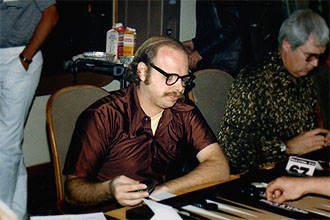|
| Magriel's NYT Columns |

Mike Senkiewicz at a Tournament in 1980. The Metropolitan Backgammon Open, sponsored by the International Backgammon Association, took place in New York City last weekend. The winner in the championship section was Michael Senkiewicz, who triumphed over more than 100 players.
Senkiewicz is a diversified gamester — a former chess senior master who is considered one of the world’s best Scrabble players. Recently he has turned his attentions to backgammon.
In other sections of the tournament, Joe Pellicane and Steve Shavel took the intermediate and beginner-level competitions, and Bruce Rand overcame Joe Mirzoeff in the consolation. A special feature of the Metropolitan Open was a concurrent doubles event, with consulting partnerships. Douglas Huch and James Pasko formed the winning combination, beating Lili Gross and Alan Martin in the finals.
The diagrammed position illustrates the turning point in Sunday’s finals between Senkiewicz and Stanley Friedenberg. At the start of the game, Friedenberg (Black) trailed Senkiewicz (White) 7 to 3 in the 21-point match. Early on, Black had doubled.
|
7
MATCH TO 21 3 |
| Black to play 2-1. |
After White’s miraculous 4-4, Black failed to reenter. Now Senkiewicz (White) made an astute decision. At this point, White, because of his strong home board, could have redoubled and collected a sure 2 points in the match. Instead, Senkiewicz wisely kept on rolling because Black still had two more blots exposed — one on the 11 point, one on the 9 point. Indeed, White did eventually hit both blots, closed Black out, and gammoned him.
Thus this one fortunate roll reversed the anticipated outcome of the game. Senkiewicz gammoned Friedenberg instead of being gammoned himself, and so widened his lead, 11 to 3. The 8-point lead proved insurmountable for Friedenberg; Senkiewicz went on to win the match 21 to 13.
The correct play for Black in the diagrammed position was 13/12*/10, hitting on the 12 point and continuing to the 10 point. This play would have been totally safe in that White, with two men on the bar, would not have been able to hit with any number on his next roll, even double 4’s.
Friedenberg’s play, 13/12*, 11/9, was not theoretically a major error, because the chance of rolling double 4’s on any particular roll is only 1 in 36. Normally in the middle game, players need not be overly concerned about such an unlikely occurrence; there are usually many more important factors at stake. In this case, however, the small risk was unnecessary and unjustified, and Friedenberg was cruelly punished for it.
He later said he feared that if he had made the recommended play, he might roll double 6’s next turn. This would legally force him to move the man now on the 10 point to the 4 point, leaving it unprotected there. His reasoning was in error, even though his concern was legitimate. The possibility of both Black rolling double 6’s and White reentering with a 4 was less likely than the chance of White rolling double 4’s immediately.
Rollout
 Tom Keith 2013 |
|
Match to 21 White 7, Black 3 White owns 2-cube Black rolls 2-1 1296 games with VR Checker play: 2-ply Cube play: 3-ply Red |
| 2-1: | Game | G | BG | Equity | ||||
| 1 | 13/12*/10 |
W L |
.9003 .0997 |
.4654 .0030 |
.0058 .0001 | +1.2667 |

| (b) |
| 2 | 13/12*, 11/9 |
W L |
.8882 .1118 |
.4642 .0130 |
.0055 .0005 | +1.2316 | (0.0351) | (a) |

|
|

